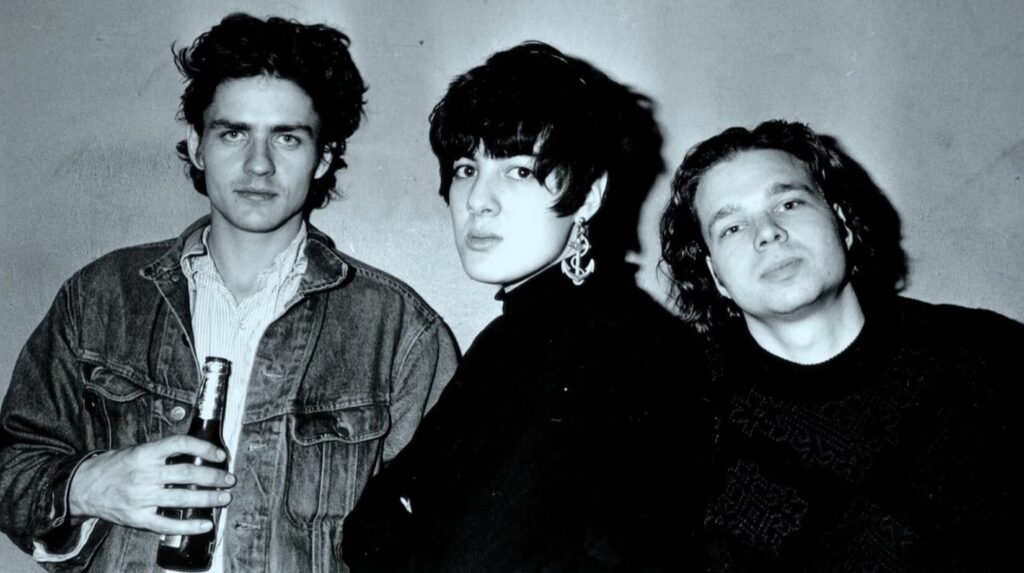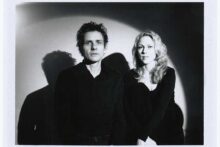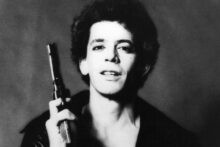Galaxie 500 could lay claim to being the finest three-piece of all time, not through force or flash but by making the gossamer monumental. The line-up was skeletal as it was supreme: guitarist and vocalist Dean Wareham, drummer Damon Krukowski, and bassist and vocalist Naomi Yang. Across just three studio albums – 1988’s Today, the following year’s On Fire and 1990’s This Is Our Music – they crystallised the indie rock dream in a form that seemed to rewrite early dream pop’s grammar in their own hand, but they spoke it with a different cadence; spacious and stubbornly their own.
The Velvet Underground comparisons are well-worn, leaned into, but they stick for good reason: the exquisite minimalism, drone and drone-adjacent sublimity, rock music pared back to its barest parts until the air around it seems to ring. But the truth is, the further we get from their final shows in 1991, the more the music of Galaxie 500 feels ripped from Orpheus, then fed through an 8-track: glimpsed and gone, made eternal by absence.
The recorded music itself – the divine analogue hiss of a slim catalogue – inverted scarcity into vastness. In an age when nearly every band has cashed in on the comeback, Galaxie 500 remain one of the last whose refusal feels, more than ever, like part of the monument.
Few bands embodied cool with such ease as the 80s collapsed into the 90s. Wareham, a New Zealand-born Australian by upbringing, lent the group a sensibility that set them apart from their Boston peers, while Damon and Naomi’s taste and restraint were as decisive as Dean’s guitar. And then there was Kramer: producer, bassist and mercurial in-house architect of Noise New York, the tiny but iconic East Village studio where so many weirdo classics of the era took shape. Kramer’s production didn’t just capture Galaxie 500; it gave them a frame, wrapping their fragility in tape warmth and negative space.
Blessedly, it left Galaxie 500 suspended between decades, belonging to neither the 1980s nor the 1990s. “I think we benefit from that,” says Wareham. “Just from sounding in-between and being ourselves and not quite knowing what we were doing. I have fond memories. Playing was always fun. Making the first record was probably the most fun. It turned out a lot better than we expected, and all these years later I find that’s somehow why I write ‘entertainer’ on my tax return.”
His lyricism remains great precisely because it shows rather than tells, fragments like “hearing voices” or the half-glimpsed scenery of subways, airplanes, traffic lights, elevators. These aren’t songs that instruct or explain but ones that let stray details accumulate. For me, it’s a sensibility closer to Wong Kar-wai than to conventional rock writing – kind of elliptical, finding weight in the incidental – and you could just as easily trace it to Joan Didion’s way of making the peripheral feel definitive. With Damon and Naomi’s rhythm section – always unhurried, almost painterly – those fragments became atmosphere, each detail fading like the memory it mirrors.
Breaking up only widened the prism. Alongside other projects, Damon and Naomi carried on as a duo, while Dean went on to form Luna, both paths perfectly rewarding in their own right. Yet together as Galaxie 500 they remain a constellation that only aligned once.
Since then, each has expanded the orbit in their own way: Damon as a writer and sound theorist, Naomi as a filmmaker and visual artist, and Dean as a memoirist and musician (his excellent 2025 solo album That’s The Price Of Loving Me was his first recorded with Kramer since Galaxie’s 1990 farewell, This Is Our Music). Through Exact Change, the publishing house Damon and Naomi run, they recently released a long-gestating memoir of legendary French filmmaker Chris Marker: a fitting echo of the trio’s enduring devotion to art that resists time.
There’s also the humour of hindsight: Damon and Dean once came last in every category at their university’s Battle of the Bands. Songs, musicianship, even looks were all marked down. Damon tells me that the winner was Dan Wilson, later of Semisonic fame and co-writer for Adele and The [fka Dixie] Chicks. Wareham remembered breaking a string during the early gig and fumbling with it for most of their allotted time. Yet out of that “catastrophe” grew one of the most quietly influential bands of the era. This is music that sounds like it subtly reveres itself, entering a small chapel of sound where every note hangs in the air like a votive.
Their refusal to reform made last year’s compilation Uncollected Noise New York ’88-’90 hit all the harder. Galaxie 500’s first release of new archival material in nearly 30 years, it stands as their most comprehensive collection of unreleased and rare recordings to date. Across 24 tracks, it captures the complete Noise New York studio sessions, including outtakes and non-album material, tracing their entire arc. Shaped in lockstep with Kramer at Noise New York, these songs are desire lines toward a certain sorcery.
More than three decades on, the devotion hasn’t dimmed. Their music stands as a kind of last light in the indie rock sky; a reminder of how much can be said with so little, how a band can vanish at their peak and only grow larger in absentia.
‘Shout You Down’ from Uncollected Noise New York ’88-’90 (2024)
Dean Wareham: I wrote the lyrics to this after going to a protest against Reagan’s Secretary of Defense, Caspar Weinberger. It was me and about 800 other people. Some were there to hear him speak and others were there to shout him down. Somehow, my friends and I got the blame, but thinking back, I was actually pretty well behaved because I was aware that I was a foreign student. We were all kinds of nervous when we went to record this and the likes of ‘Tugboat’ and ‘King of Spain’ in the first session with Kramer. We were there for just two days and we thought he was a genius; a very skinny genius. I think the tendency for bands is that you do your first record really quickly and the longer you’re together, the more complicated it becomes. We were spoiled by it happening so quickly and seeming so easy.
Damon Krukowski: Back then, the three of us used to go to every Feelies show in Boston, so I think you hear a little bit more of that influence without any of the development or masking on some of this one. We were trying to make something cool and something that was our own. When I listen back to it now, I’m like, “Jesus, it’s so fast!” I think we sort of learned that when we slowed things down, we became more original and more ourselves. We used to rehearse these grooves ad infinitum. We were the furthest thing from a jam band, but the way we wrote and arranged our songs, it was like a jam band.
Actually, did you write any bridges? I can’t recall a single one.
DK: I don’t think we knew about bridges! Definitely no key changes or elaborate chord changes. If you think about the way Can plays, they don’t really have middle-eights or bridges, but they have other weird sections and spliced tape a lot. So I think that would account for our lack of them. As far as I know, what are now called pre-choruses didn’t exist in 1988 and 1989. When I heard the term decades later, I was like, “Pre-chorus? What the fuck is that?”
DW: A bridge can be a wonderful thing, but some people don’t even write choruses. Like Dylan barely writes a chorus. There’ll be a refrain he’ll just sing, then there’ll be two lines that he’ll repeat. Serge Gainsbourg also liked to just get on one thing and stay on it. He’d be like, “This groove is working. Why would we go away for this?”
‘See Through Glasses’ from Uncollected Noise New York ’88-’90 (2024)
Naomi Yang: This first Today session felt like a kind of miracle. Like, “Oh, wow, we can sound like this,” especially with Kramer’s willingness to push the effects. Kramer is such a strong personality; you don’t forget him. He had been in the business so long and had been in so many bands, so we were very excited to work with him. It was a real revelation to hear our songs transformed by his productions and ideas.
DW: This one is mostly one chord, and when we do finally change, it feels very powerful after hanging on for a long time. It’s a bit like our version of Jonathan Richman’s poem ‘Don’t Let Our Youth Go to Waste’ mashed up with different chords. To me, it sounds like we were learning as we went. I always think it’s pretty easy to start writing a song, a bit of an arrangement and everything, but it’s hard to finish one. I’m learning some Dylan songs right now – myself and Britt [Phillips, Wareham’s wife and fellow Luna member] are playing at the Bob Dylan Center in Tulsa soon, and there are like six verses to a lot of his songs. Which is great, but sometimes a few words are just fine, too.
DK: Listening back, I am struck by the outros on more than one, including this one. I can hear it on our more well-known work, like our first 7”, ‘Tugboat’. It was like, “Ok, let’s play this riff for way too long.” But something’s got to shift, and it was usually a rhythmic shift. We used to call them ‘rave-ups’ in the band. I think that’s something we took from bands we loved. Like, the Velvets have rave-ups in our mind. The Feelies have rave-ups. It’s like an outro, but you have to kick it up in energy somehow. The other thing about these early tracks is you’re hearing us before we were reviewed. The UK music press all told us we sounded like people we didn’t know; stuff like Tim Buckley and Nick Drake. Then, later, they started to call us pastoral. We were like, “Pastoral? We grew up in Manhattan.” Even in Dean’s lyrics, you hear a more snotty attitude. It wasn’t cool to be romantic or starry-eyed in our scene. It was more like, “Fuck you! 1-2-3-4.”
‘On The Floor (Noise NY Version)’ off Uncollected Noise New York ’88-’90 (2024)
DW: Going back and listening to a song like this, I realise how many of them were directed at my girlfriend at the time. It’s funny: you write these love songs where the love may end, but the song lives on longer. A part of the reason I was up in Boston was because she had broken up with me, so I was like, “Ok, I’ll leave New York then and go up to Boston with Damon and Naomi, and get over my heartbreak.” Then we wound up seeing each other again anyway, then we got married… and then we got divorced. I guess by the time we got around to putting out Today, we thought we had stronger songs than ‘On The Floor’. I think it was maybe inspired by George Harrison; songs like ‘Alive Without Travelling’, where it’s just this drone. I think I speak for all of us at the time that George was our favourite Beatle.
NY: Yes! George is still my favourite Beatle!
DK: No objection here.
‘Can’t Believe It’s Me’ off Uncollected Noise New York ’88-’90 (2024)
DW: We did this one so quickly, but when we came back and did it as ‘Pictures’ on Today, Kramer was a lot more involved with the production. He had Naomi double the bass part, which was part of what made that sound really cool. And the lyrics are more finished. I guess ‘Pictures’ is more of a standard love song, and ‘Can’t Believe It’s Me’ is more of a weird, existential thing. It was just me riding the subway car at the very front and just watching the tracks unfurl in front of me.
DK: This one is definitely pretty damn successful, certainly from our early period. It’s very much the Velvets’ third album for me, and I’d moved the whole drum part to the floor tom alone in a sort of Moe Tucker homage, and you can hear Naomi has developed a whole lot more on the bass. I think we would’ve released it had we not stolen our own chord progression.
NY: When I first took up bass, people were like, “Oh, it’s easy. You just play the root note and follow along.” That didn’t seem so interesting to me. I always loved singing, and I can remember melodies from any song if I just hear it once. Our friends in the Japanese band Ghost always say, “You’re playing that singing bass.” Of course, there are many bassists, like James Jamerson, who are amazing at playing the root note and really incredible rhythmically, but that’s just not how I play. I’ve always said in my next life, I want to come back as Bootsy Collins.
DK: What I like about the new compilation is that it does honour the time with Kramer at Noise NY. None of what we recorded would’ve sounded the way it does without him, that’s for sure. I sort of view it as similar to relationships like Martin Hannett and Joy Division or George Martin and the Beatles. That was an ideal for me, even then: how do you take what you do in your rehearsal space and on stage and make it into actual, great albums? Kramer was the only engineer at Noise NY, and he was affordable. He rented you a tape by taping over other bands he had recorded. He did that with our master tapes, too, unless we paid more to walk out with them. In that first session, we were ecstatic because we sounded better than we did to ourselves. His reputation preceded him, and when we signed to a label, it was clear they didn’t want us working with him. Our records were pretty weird, distinctly unfashionable, and we insisted on keeping him. When we were negotiating with Columbia Records, we wrote in that Kramer would produce our records. There was a band meeting in a skyscraper next to Carnegie Hall with our lawyer, Richard Grabel [also representing Sonic Youth and Dinosaur Jr.]. He said, “I want to make sure you’re all in agreement about this.” We agreed, and then Dean quit the band. Cause and effect are up for debate, but we were insisting on Kramer. The idea of switching that would have completely changed the sound. In some ways, it makes sense that the band broke up once we stopped working with him.
‘I Wanna Live’ off Uncollected Noise New York ’88-’90 (2024)
DW: I don’t know why the hell it was, but this one was subtitled ‘The Disco Song.’ The sentiment is very Jonathan Richman, who was obviously a big influence on us at the time. It reminds me of ‘I’m Just Beginning to Live’ by him. This one wasn’t quite finished and maybe a little out of my vocal range, too, but it finishes with a bang when it does. Listening back, I can hear the room that we were in. I can still see the wooden floor, the bricks, and the little closet that Kramer worked out of. Again, the longer bands are together… There’s that joke: “How many producers does it take to screw in a lightbulb?” “I don’t know, what do you think?” But I still love playing our songs. There are songs that I’ve done that I’m really sick of, but I don’t even feel that way about Galaxie 500 songs.
NY: This was a really nice time in the band, and everyone was working as a team. We were excited about a lot of possibilities, like working with Rough Trade, who were so supportive. I feel like this one has a different mood. In some ways, it’s simpler and more like the songs on Today. By On Fire, the songs were getting a little less straightforward. It doesn’t mean it’s a bad song – I just think it would have pushed On Fire in a slightly different direction.
‘Never Get To Heaven’ off Uncollected Noise New York ’88-’90 (2024)
DK: I really like this one. There were new chords we were finding at this time, pushing toward more melancholic formulations. I don’t fully remember who came in with it, but it sounds like me. We would bring riffs in and change them so much they’d move far from [where they started]. I remember arguing with Dean, playing him the original tape of a riff he’d brought in. We’d changed it so much he didn’t even recognise it as a song on the album. It’s been said in interviews that I brought in the riff to ‘Tugboat,’ which is absurd. I didn’t sit at home and play ‘Tugboat.’ I sat at home and played G and C that we jammed on. And I had to be prodded to remember those were mine. “Look at me, I’m playing a major 7th chord.’ It’s like, yeah, Damon, they’re all major 7ths.
DW: I don’t know what the hell I was on about, but it just occurred to me: “I’ve never been to Spain…” reminds me of Elton John’s ‘Daniel’: “Daniel is travelling tonight on a plane, I can see the red tail lights heading for Spain.”
‘Maracas Song’ off Uncollected Noise New York ’88-’90 (2024)
DW: I think Damon also came up with the chord progression for this one. It’s a song about shopping in the heat in New York City, feeling depressed and as bored as can be. “I went up to Times Square/ Bought myself a pair of shoes.” I didn’t even go shoe shopping on Times Square; I went shoe shopping on 8th Street. It’s another one of those ‘one verse and one chorus’ things that just repeats. Sometimes they came together in a great way, but in the case of ‘Maracas Song,’ it’s one that died on the lyric. Ultimately, I don’t think any of us were very focused on the lyrics. It was an excuse to sing the song. What we were really looking for was atmosphere and a groove. It didn’t quite fully come off on some of our released material, but I do think what you hear in all of them is us searching for a groove that we could play and stick with.
NY: You can move to Galaxie 500, which is something that Damon and I always felt proudest of as a rhythm section. Damon’s mother was a jazz singer, so he grew up listening to jazz drummers. So swing was really important. There is a lot of slow music with no groove to it. Sometimes people have been like, “Oh, you’d love this band, they’re super slow too.” And it’s like, ‘Yeah… [but] they’re just slow.’ What we did wasn’t slow for slowness’s sake.
‘Fourth of July (Video Mix)’ off Uncollected Noise New York ’88-’90 (2024)
DW: This one gave a nod to the Velvets’ ‘Candy Says’ and most of my lead guitar at the end is played super high on the neck, which is a kind of metal thing to do. The video shoot for this was fun, too. Sergio Huidor, who is a friend of Damon and Naomi’s, would just do the videos in our tiny, little practice space. It was amazing how he created this whole world. All of the Galaxie 500 videos are beautiful, really.
NY: This was an edit because to have a video on MTV, it had to be short enough. Nothing was automated then, so Kramer couldn’t just be, like, “Ok, I’ll just fade it earlier.” He had to redo it. It’s hard because when you’re on a non-digital board, actually fading things in real-time. There’s no digital record of that.
DK: I can hear some new influence late in Galaxie’s timetable here. At this point, Naomi and I were listening to Can constantly at home, dreaming of being a rhythm section like Holger Czukay and Jaki Liebezeit. I think that was a riff that I brought in, as I thought Naomi and I could build that feeling of a groove to, rather than the sort of Velvetsy thing that we had been doing ad infinitum. I was completely copying from Future Days. I’ve never recorded to a click, but I don’t have Liebezeit’s incredible internal clock, so it’s flawed to my ears in that way. But you can hear where I am doing my best to imitate him. I think failing, but I’m trying.
That intro has always reminded me of ‘She’s in Parties’ by Bauhaus and Aerosmith circa Draw The Line.
DK: Aerosmith, my God. I was 13 when Toys In The Attic came out and memorised it back to front. Naomi’s amp – the Ampeg B-18 she still records with – came into our lives because Kramer had the classic B-15 at Noise New York. Before that, she was using a terrible Peavey. Then she plugged her Gibson into the B-15 and it was magic. You can hear it on those first Uncollected Noise New York tracks. That tone was there from the start. We came home and found a B-18 in the classifieds – this was pre-internet – and went to check it out. The seller turned out to be Aerosmith’s touring keyboard player, gold records on the wall, real furniture… we still had futons. The amp was in the bedroom with a lamp on it. He said, “My girlfriend wants it gone. She says it’s a side table.” We bought it. Naomi still records with it. It’s in our living room now – with a lamp on it.
‘Here She Comes Now’ off This Is Our Music (1990)
NY: Sometimes I’d just play a root note if it matched the drone. That was the appeal of doing this song. Covering a band you love lets you step inside it – it’s just a fun thing to do.
DW: It wasn’t something that we were trying to hide that we were into the Velvets, but I do think we sound pretty different. We sound a lot wetter in terms of reverb sounds. They’re a very dry, in-your-face band. We did this cover for a Velvets tribute album, but we liked it so much we thought we’d keep it for ourselves. There was no YouTube back then, but we got a chord wrong. [picks up guitar and plays] “Oh, she looks so good / Oh, she’s made out of wood.” It should go to a B♭, but I went to an A. B♭ is more interesting; A is fine too. The whole “Hey Lou, where’s the fourth chord?” thing? Plenty of their songs have a ton of chords and modulation, whereas a lot of Galaxie 500 songs are just two or three chords. For this cover, Kramer did a really cool vocal arrangement at the end. I think it’s quite stunning.
DK: By this point, I had gotten so self-conscious about the signalling of what covers meant. I mean, ‘Ceremony’, for God’s sake. That was so sly. To slow it down and everything: that was like a gift to UK music writers. We loved the song and were so influenced by New Order and the Velvets that covering them outright seemed too obvious. Everyone was obsessed with White Light/White Heat, but nobody covered this one [that is, not until Nirvana’s version a few months later].
DW: I remember, on the first night of Luna’s 1993 tour with the Velvets, in Edinburgh at the Playhouse Theatre, we were downstairs in this beautiful, old dressing room and could hear them soundchecking ‘Venus In Furs’ through a little speaker on the wall. I think it was Sterling Morrison who said something to the effect of, “If you want to get something done, send the Velvet Underground to play them ‘Venus In Furs’. Nobody else sounds like this, do they?” It was true. Later, Lou invited me into the dressing room to chat. Two people followed and he said, “Are you guys journalists?” They said yes. “Then get the fuck out of here! This is a private conversation.” He loved to antagonise British journalists, in particular. I think it’s something he picked up from Warhol – a way of not answering questions and coming up with absurd replies.
‘Submission’ from Peel Sessions (2005)
NY: It just felt so glamorous doing Peel Sessions. All these bands we loved had done them, so it was exciting. And [playing The Sex Pistols] was so fun because no one ever thought we were punk rock. It was always, “Galaxie 500? They’re slow, they’re quiet…” But punk was such a big influence for us, and it was fun playing against type.
DK: Our first Peel session was a little embarrassing because hearing us without Kramer wasn’t as good as the album. The second time, we decided to do nothing predictable, so we did covers. Dean and I had played ‘Submission’ in college, and I think it really worked here. The studios and the aura of the BBC were incredible. The first session’s producers didn’t like our music. We were assigned the staff producer: the drummer from Mott The Hoople, Buffin [Dale Griffin]. Two bored guys, total 70s characters with beards when nobody else had beards. They were like, “Alright, what do we got today?” and we had nothing to offer them. They were punching a clock, wouldn’t let you go a second over. It was kind of an unpleasant sensation, but the studio was magnificent. Afterwards, we thought, “We could’ve done something cool and we didn’t.” So doing a Sex Pistols cover when we were invited back was a solution.
Just when you thought we’d left the Velvets, that opening reminds me a bit of ‘Sweet Jane.’
DW: Oh, interesting! That had never occurred to me before, but yeah, I can hear it. Damon and I had been playing ‘Submission’ for about ten years, first trying it out in [their early Harvard punk outfit] Speedy and the Castanets. I had a cassette of us playing it super late one night in my dorm room very loud, and I think I was probably on drugs. My graduate advisor lived downstairs and came up screaming at me because it was thumping through the floor. But on this Peel version, I’m struck by how good our playing is. Powerhouse drumming from Damon, Naomi’s bass is really good, and the guitar solo’s kind of impressive. A Peel Session should be an opportunity to take a risk and do something different – so we did.
Dig into the outer reaches of the Galaxie 500 back catalogue on Bandcamp






